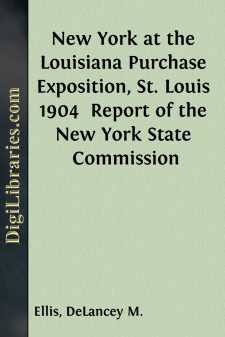Categories
- Antiques & Collectibles 13
- Architecture 36
- Art 48
- Bibles 22
- Biography & Autobiography 813
- Body, Mind & Spirit 142
- Business & Economics 28
- Children's Books 14
- Children's Fiction 11
- Computers 4
- Cooking 94
- Crafts & Hobbies 4
- Drama 346
- Education 46
- Family & Relationships 57
- Fiction 11828
- Games 19
- Gardening 17
- Health & Fitness 34
- History 1377
- House & Home 1
- Humor 147
- Juvenile Fiction 1873
- Juvenile Nonfiction 202
- Language Arts & Disciplines 88
- Law 16
- Literary Collections 686
- Literary Criticism 179
- Mathematics 13
- Medical 41
- Music 40
- Nature 179
- Non-Classifiable 1768
- Performing Arts 7
- Periodicals 1453
- Philosophy 64
- Photography 2
- Poetry 896
- Political Science 203
- Psychology 42
- Reference 154
- Religion 513
- Science 126
- Self-Help 84
- Social Science 81
- Sports & Recreation 34
- Study Aids 3
- Technology & Engineering 59
- Transportation 23
- Travel 463
- True Crime 29
New York at the Louisiana Purchase Exposition, St. Louis 1904 Report of the New York State Commission
Description:
Excerpt
HISTORICAL SIGNIFICANCE
[ILLUSTRATION]
The Louisiana Purchase Exposition was held in the city of St. Louis in 1904, in commemoration of the acquisition in 1803 of the vast territory west of the Mississippi, then called Louisiana. The transfer is generally regarded as one of the most important events in our national history and stands on record as the greatest acquisition of territory ever made by peaceful methods. An American historian of great prominence says: "The annexation of Louisiana was an event so portentous as to defy measurement; it gave a new face to politics and ranked in historical importance next to the Declaration of Independence and the adoption of the Constitution."
The territory was ceded to France by Spain by the secret treaty of San Ildefonso in 1800. This aroused to intense excitement the people of the West, who were inclined to give credit to the rumor that the army of forty thousand men sent by Napoleon (who was responsible for the negotiation of that treaty) were in reality to take military possession of Louisiana and the Floridas instead of to suppress the insurrection in San Domingo, the ostensible object. France and England had been struggling for many years for supremacy in the Western Continent, and in the possession of this vast territory Napoleon foresaw a prosperous New France. But there were many complications arising at home. Important political questions demanded attention, and the great Napoleon soon realized that he could not hope to cope successfully with the two great problems lying at such a great distance apart.
NEGOTIATIONS FOR TRANSFER OF TERRITORY
At that time our country was interested in procuring possession of the site of New Orleans and the free passage of the Mississippi river forever for all American citizens, and negotiations were opened for their purchase by Thomas Jefferson, author of the Declaration of Independence, and at that time third President of the United States.
During the negotiations Napoleon suggested the transfer of the whole Louisiana territory and the transaction was brought to a most successful conclusion, the signers of the treaty being James Monroe, Robert R. Livingston, and F.B. Marbois, the representative of Napoleon. It was a significant bargain. By it Napoleon formed closer bonds of friendship between France and the United States, and prevented any possibility of the territory falling into the hands of Great Britain. He prophesied that this Republic would eventually become a world power and a commercial rival to England. How completely his prophecy was fulfilled. Our country attained possession of a vast territory embracing more than a million square miles, an area greater than the combined areas of the British Isles, France, Germany, Spain, Belgium, the Netherlands and Italy, the consideration being a figure less than that representing the value of a single square block in any one of our great cities, or an amount much smaller than has been yielded by any one of many mines within the boundaries of the territory....


